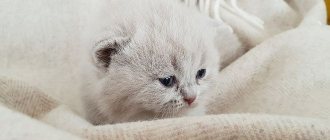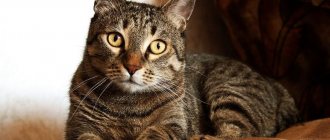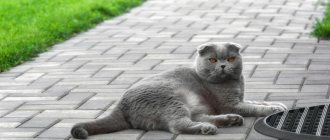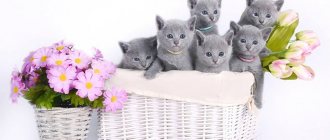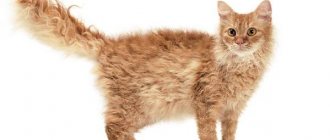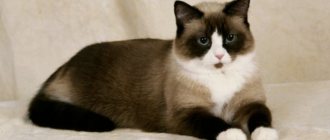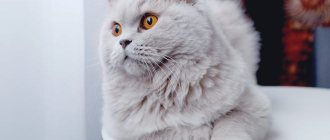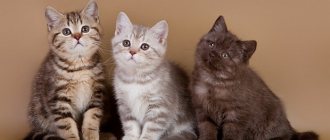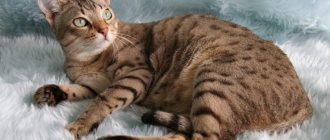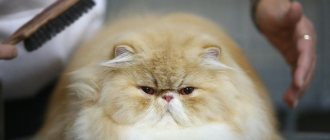The Lilac Briton was developed relatively recently as a result of experiments by breeders who were interested in the development of the breed. In the light shades of this color you can guess the blooming lavender, and the dark ones are more like the color of traditional English milk tea.
The cat with unusual fur quickly gained recognition in the international expert community. Let's find out if there is a relationship between the color of the fur coat and the character of the pet.
The history of the appearance of true British colors
The main role in the formation of new colors in cats belongs to genetics. The first cats bred without any rules, since the survival of the species was the main goal. But when the cat became a pet and settled next to a person, the situation changed dramatically.
The owners wanted to make some parameters more predictable in order to get kittens with a certain coat color.
Important! Based on the variety of registered colors (more than 200), the British cat ranks one of the first places in the hierarchy of cat breeds. The trademark is solid coat colors.
The gray-blue shade has been recognized as the main color for British Shorthair cats. The further evolution of colors began with him. The main achievements of the debut period are attributed to the English artist Harrison Weir, a great lover of British cats and a specialist who compiled the first standard of this breed.
During the selection, a line of solid colors was fixed, where, in addition to the main one (often called British), a palette of white, black, blue, cream, chocolate and red appeared. And at the end of the twentieth century, a purple tint was added to them.
Important! According to the rules of solid colors, the fur of a lilac British cat must be dyed from root to tip in one even color, without half-tone transitions.
Who is the color suitable for?
A traditional British cat with a blue color in its disposition, manners, cleanliness, and independence is suitable for:
- For lonely people, she will become a pliable, affectionate, loyal friend.
- For large families with children, she will make friends with everyone.
- For busy people who are not at home for a long time, she will not be very bored or mischievous, and will calmly wait for her owner.
Advantages and disadvantages
Striking in appearance with its beautiful, velvety, noble, blue-gray fur, the British cat has gained recognition due to its amazing character. Positive qualities include:
- unobtrusive;
- independent, self-sufficient
- does not require special care;
- experiences loneliness with dignity;
- balanced;
- clean;
- trainable;
- has a healing, calming effect.
There are no negative qualities, except for a fairly high price for a kitten; financial investments are required for maintenance. But a noble, intelligent pet will appear in the house, the joy and pride of the whole family.
https://youtube.com/watch?v=H7F0e8-UnZU%3F
Types and standard of lilac color
There is no such thing as monotony in nature, and the lilac color of the British is proof of this. It exists in three versions:
- Lavender light shade – close to the cold silver color of the metal.
- Warm cream lilac is the most common color.
- Dark Isabella – rich coffee with cream.
The alleles (types) of two genes are responsible for the process of coloring lilac British cats:
- Black color in cats is represented by the variants B (black), bb (chocolate) and blbl (cinnamon, cinnamon).
- Saturation depends on the lightening gene D, which exists in the combination dd (there is lightening) or Dm (caramel).
The aa (non-agouti) locus is required for solid colors. It is responsible for the lack of tabby pattern on the coat.
The color tone of British lilac kittens depends on the hereditary instructions that are passed on to babies from their parents. Breeding programs do not recommend mating with two partners with shades of lilac.
This leads to a deterioration in color - kittens are born with a dirty gray coat. Therefore, for mating with lilac, ginger cats (males) are usually taken.
British genetics have already identified patterns that can be used to predict the color of kittens in a litter.
- A lilac cat and a red cat give birth to lilac boys and lilac-cream girls.
- From the lilac cat and the red British cat you can only expect lilac and cream babies.
- But lilac kittens are never born from a ginger (red) couple.
In addition to the continuous cover, the lilac color appears in various combinations with other types of color.
- Tortoiseshell, where purple is a modification of black.
- Bicolor - lilac and white, rarely found in British cats.
- Smoky shades, when the root part of the hair is weakly colored or remains white, and the pigment only works on the ends of the hairs.
- Acromelanic color point - a lilac mask of varying saturation on the face and body parts: ears, paws, tail.
- Tabby is a purple coat pattern that sometimes fades into darker colors.
The lilac color in the British cat occurs in approximately 15-20% of matings, but solid colors are not common - they predominate in targeted breeding.
This is interesting! Over the century and a half of its existence, British cats have conceded the palm to other breeds several times. But since the beginning of the 21st century they have come back into fashion and become the most widespread group in England.
Real encounters from real stories
Lilac Cat
Hello! I want to tell you about my date))). With girl. Are you even a little intrigued?
So, about... I'll see now... 3 years and 4 and a half months, to be exact, since I registered on this site. I found him through a search engine, out of boredom, typing “life stories” into Google at work. I found it, read it, registered, wrote a couple of stories. I settled in and began to feel at home. I am anti-social. networks, but somehow I fell in love with this forum and became attached to it. I “communicated” with several users. I found friends online. But since I am from Ukraine, and everyone I made friends with here are Russians, our communication remained online. I started to communicate with someone more closely, on Skype, with a webcam, but gradually faded away; I still keep in touch with someone. I got distracted.
And so. Somewhere... I'll look now... almost a year after I registered, a girl appeared here. I unfollowed her story. I won't create mystery. This girl is Anya, Destiny. Good girl. Kind, fair, pleasant to talk to. Gradually, from the comments, I realized that she, like me, is Ukrainian. We didn’t communicate, so we “dazzled” each other in stories. I, as always, was as sharp as diarrhea, she was more diplomatic, restrained.
Once, I don’t remember, I think it was a birthday or some other holiday at work. We had all the cognac connoisseurs there, I don’t respect strong drinks, but I drank with them for company, and in order not to break away from the team, then on an equal basis. I came home normally, so drunk. My Vitaly went to bed, and I, as often happens, stayed up at night. I went to our website and unsubscribed somewhere. I see a message. Destiny. We talked through messages and she asked for my phone number. I don’t really like new people, and it’s quite difficult to get along with them. I don’t add everyone who asks to be my friend, I close my personal account. But I was drunk. And I sent her the number. We called immediately. And we talked for 2 hours, if my memory serves me correctly. It’s strange, but it instantly became easy with her. We talked about everything under the sun. Then we called again. And further. And somehow we got used to calling each other.
Then Anya had some problems with work. I advised as best I could. I probably advised what she herself felt, because she left her job. And everything worked out for her (this is looking ahead). We began to communicate closely. On the phone almost every day, for a long time. Sometimes, however, they might not talk on the phone for weeks, but then they were there again and communicated as if nothing had happened, sharing with each other everything that had happened.
After some time, the idea of meeting in real life came to mind. We live quite far from each other, between us Kyiv is the capital. It was decided to meet there. It’s closer for her to go, for me it’s 2, or even 3 times further. But our meeting fell through. Anya literally hit the asphalt with her knees before leaving and did not want to go to Kyiv as a disabled person. About a year later, we got ready to meet again, but unforeseen circumstances arose again. In principle, I decided that it was not fate and gave up on this idea.
And then summer came. We're lost again. Vacation, sea, I ran around. Anya has her own worries. We didn’t talk on the phone for quite a long time, although she knew about my plans for the summer, I shared and consulted. I went to Minsk, then flew to the seas. Only upon arrival, already in August, we called. And somehow suddenly a spontaneous decision came: we definitely need to meet. When you plan, nothing happens. When the decision is spontaneous, everything turns out as it should. On Sunday we decided that we were dating, and on Wednesday I was already sitting on the train on the way to Kyiv. I have to go for about 5 hours, I got up at half past three in the morning. Vitalik twirled his finger at his temple. He doesn't understand. We called 20 times on the way: “Is everything okay?” - Yes, I'm already on my way. - Well, I woke up, I’m getting ready to leave.
She arrived an hour earlier than me. We agreed that he would meet me at the station. When I was approaching Kyiv, we called again. Everything seems to be fine, in place. I get off the train. Anya is not there. I turn my head. Anya is not there. I'm calling Anya. Anya doesn't answer the phone. I'm calling again. And further. I'm calling another number. Same result. For a second the thought arose that people are different, and their sense of humor may be different. My imagination painted a picture of the treacherous Anya at home, laughing at the fool Olya, who had trampled herself 400 km away. And then I saw a symbol - a blue dress with white flowers and Anya, whom I had seen many times in photographs. She ran towards me along the platform. She was the same as in the photo, and at the same time, completely different.
Well, we met, kissed and went to the subway. It was decided to go to the water park in advance. The first 20 minutes were a little awkward (at least for me). But it went by very quickly. Then everything was very relaxed and sincere. We searched for an ATM, then searched the entire shopping center for a water park. We found it, were happy, and landed.
Well, it’s not interesting to tell further. In a nutshell: we had a great time. Anya can’t swim, and I tore my swimming trunks on my butt (well, as usual), but it was still very cool. We rode down the slides, lay in the jacuzzi, and ate pizza. I felt good.
Then we went for a ride on the water bus (Anya’s idea, thanks to her for it). Maybe our couple of years of telephone communication had taken their toll, but it was easy, we talked about everything (we even discussed the site a little, and washed the bones of the users). I speak for myself, at the end she will write her vision of this meeting, but I really felt very good and calm with this person. Yes, we had grievances with each other before. I was offended, and she knows why, and I also know when she was offended at me for my harshness sometimes, and in general, I’m not a gift. I take this opportunity to apologize if I ever offended her. But we also helped each other out more than once. Even without seeing each other, I trusted her, tried to help whenever possible, and she did the same to me. Remark: Thank you Anya, your help and advice (on work and not only) were very valuable. I remember everything, I haven’t forgotten))).
The day was long, but it ended quickly. We ate ice cream each and went our separate ways. She's on a minibus, I'm on a train. I arrived home at half past four. Exactly one day later. Tired but happy. I got up at 9 am and went to get my eyelashes done. I called Anya and listened to her sleepy mumble that she was still getting some sleep. Now let's call each other again.
I'm sure this is not the last meeting. There will still be winter holidays, and then summer holidays again. Speaking for myself, I know for sure that I will want to see you again. Anya is a good person. Kind, tolerant, positive. I appreciate that in people. I want to say thank you to this site that it not only allows people to speak out and get life advice, but also helps people find friends.
As always, I have a problem with how to finish. I think she said everything. Thank you Anya for a wonderful day, thank you to the site for existing, thank you for reading. Now Anya wants to say something.
Destiny
I'll add a couple of lines from myself. I came to the site in 2014, I knew about the site’s existence for a long time, but I never commented, but here I also wanted to somehow help with advice and share my experience from my life. I didn’t come to the site for the purpose of communication, I was just interested in reading about people’s fates, I just wanted to help in difficult times and didn’t even think that here you could also communicate and find friends. But little by little I got involved and began to remember the regular users.
I noticed a girl with the amazing nickname Lilac Cat right away. It’s just that her comments really stood out from the rest; she knew how to accurately, succinctly describe the situation and give a correct and accurate assessment of everything that was happening. Somehow we developed an invisible sympathy, we “dazzled” each other, since our points of view often coincided and I was very interested in how she writes. By the way, before this, many users wrote to me in personal messages, with whom I began to write little by little, that you are probably very friendly with the Lilac Cat. But I said no, we just sympathize with each other, that is, our sympathy was visible...Then we finally texted each other...It’s interesting, I love writing, but I don’t really like just texting, so I suggested calling him on the phone. She agreed and we chatted for two hours about everything under the sun.
Communication was easy, relaxed, as if we had known each other for a long time. So we began to communicate and share a lot of what is happening in our lives. There were thoughts about a meeting, and last summer we agreed to meet, and Olya was going to book tickets, but literally the night before I was walking home in short shorts in the evening and, as luck would have it, I slipped and fell with all my might on my knees on the stones. My knees were bleeding, I couldn’t even move around the apartment and, naturally, there was no question of any trip. It was terribly inconvenient for Olya that I was so clumsy((((. A year passed, we were both working and there was no time, and now it’s the long-awaited summer, when there’s a vacation and you can finally allow yourself to relax. And so we decided to meet. I was very happy about it , for some reason it seemed to me that everything would be easy and good.
As usual, we decided to meet in Kyiv. It’s closer to Kyiv for me, so the plan was this: I get to the Zhitomirskaya station, and then go to the Vokzalnaya station and meet Olya. I arrived safely, and twenty minutes before Olya’s arrival I was at the station. But I mixed up the station, there is a Suburban station and a central one. And so I wandered around the suburban station and looked for Olya’s train, until I decided to ask the cashier and she sent me to the central one. By the time I found Olya’s train, it was already 10 am, and Olya had already arrived, the station was crowded and therefore I didn’t even hear her call. And so I run up and from a distance I see a curly-haired girl with laughing blue eyes. I realized that it was her, the dear Lilac Cat. Of course, it was indescribable to see the smile, eyes, face of your cute virtual friend. She is very easy to talk to, yes, yes, those who think that she is harsh and rude, no, she is a very simple, easy to talk to person. We laughed, joked, and overall the day was great. I also want to tell you, Olya, I admire your fortitude, your character and human qualities. You helped me many times, me, just a girl you knew from the Internet. Thank you for helping me with my work and thanks to you my life has changed for the better.
We gave our word that once a year we will definitely meet, no matter where, in Kyiv, Odessa or another city, the main thing is to meet and once again hug each other and share our most intimate things. Make friends, communicate and know that on Rear Ru you can meet true and loyal friends!!!
General appearance of the breed and its changes since the beginning of breeding
The appearance of the British cat changed depending on the celphelinologists and breeders. To understand what this cat was like at the very beginning of its pedigree, you can turn to the work of the artist Harrison Weir, discussed above. He was a great animal lover, participated in many clubs and often depicted pets in his paintings.
The first images show a medium-sized cat, in a solid gray-blue color or bicolor (white with dark accents). At the end of the 19th century, the British still had long hair, which they obtained as a result of crossing with other breeds.
Later, work was carried out to consolidate individual characteristics. Breeders paid attention to the color and quality of the coat. As a result, the British cat's fur coat became like a thin plush with a stable gray-blue color.
During the First World War, purebred animals became a rarity. Long-haired Persians and other exotic breeds came into fashion, and the descendants of local rural cats faded into the background.
To save the native species, breeders even crossed the British with the French Chartreuse-Carthusian breed, which were not genetic relatives, but were very similar in appearance to their English counterparts.
Somewhat later, the descendants of mixed “marriages” with Persians were identified as a separate long-haired breed, and by 1970 the true British formed the type of cat that exists today.
- The cat is medium-sized, squat, with a well-developed chest.
- The head is rounded, with large cheeks.
- Wide set ears.
- Large round copper-orange eyes. Depending on the color, their color may vary.
- The cat's tail is of medium length, wide at the base and rounded at the tip.
- Short (relative to the body) legs, full rounded paws.
- The coat is dense, thick, and short.
For British cats, more than 200 types of colors are allowed, including new colors - silver, gold, lilac.
Breed characteristics
Lilac color (lilac) is one of the most interesting among all the colors of this breed. It was bred relatively recently as a result of long work by British breeders. The shades may be of different intensities, but only specialists will be able to distinguish them:
- Light purple (reminiscent of pink).
- Medium saturation.
- Dark purple.
Appearance Features
Lilac is a cool gray color with a slight pink undertone. According to standards, the color must be uniform and evenly dyed along the entire length of the hair. Small spots may be observed in kittens, but they should disappear by 6 months. The undercoat is usually very soft and may be of a lighter shade.
These animals are quite large, with a proportional and powerful build. A little squat. The chest is developed and distinguished by massive muscles. Males can weigh about 6 kg, and females - 4 kg.
The head of this breed is quite large, with smooth outlines. The nose is wide, and the cheeks are plump. There is a small fold on the neck. The paws are strong and round, but rather short. The ears are relatively medium in size, with rounded tips. There is a large distance between the ears. At birth, kittens have a gray iris that changes over time.
Eyes can be:
- copper;
- amber;
- orange.
Character and behavior
The character of lilac Britons is not much different from other representatives of this breed. Such animals have true English aristocracy, independence and friendliness. They do not require affection, but at the same time they will not tolerate rudeness or neglect. This breed has a well-developed sense of self-esteem. They do not like to be picked up, but even in this case they will not show aggression towards a person.
These animals are very loyal to their owners. They differ from other cats in that they treat all family members equally and do not choose one owner. They will be bored when apart, but in general they tolerate loneliness well. You can safely leave them alone; such pets will not cause chaos in the house.
This is a very sociable, friendly and playful breed. They like to have active fun until they are about a year old. You can easily have such a cat in a house where there are small children. The Briton will become an affectionate and loyal friend for them. They can be scratched behind the ear and carried in your arms; they will only release their claws when offended. They are distrustful and a little wary only of strangers.
Despite the fact that they love to play, they cannot be called hyperactive. They need personal space - a small secluded place that they choose for themselves. These animals really like to climb onto the upper tiers of furniture and watch what is happening from there.
The British show their love by lying down next to their owner or vigorously rubbing themselves against his legs. These animals get along equally well with other cats or dogs.
This breed is distinguished by high intelligence and intelligence. They will not need long to instill norms of behavior. Even small kittens very quickly learn to go to the litter box and scratching post. They clearly understand where their toys are and what things they shouldn’t play with. With age, the British can even understand the mood of the owner and the tone of his voice.
After eating, they need some time to rest. After sleeping, these cats are ready to play again. With age, they become calmer and begin to prefer sleep or contemplation to fun.
The owners speak very warmly about this breed and especially note the following:
- Cleanliness. Such pets spend a lot of time caring for their fur coat.
- Beautiful appearance.
- Tolerant, friendly and calm character.
- Easy care.
- Unobtrusiveness.
Do external factors affect the preservation of coat color?
All possible types of color transformations are subject to five rules:
- Age-related – in cats, children’s fur changes color towards puberty. The process of changing shades occurs in two directions: from light to dark and vice versa. Sometimes in the early period small spots may appear on solid colors, but later they disappear. The British lilac cat is prone to such changes in external characteristics.
- Weather - under the influence of ultraviolet radiation, the color of the coat becomes less saturated. Isabella lilac is quite capable of temporarily turning into lilac, but if you reduce the Briton’s exposure to the sun’s rays, the color will return to its original state. In the case of the lilac color-point, high ambient temperatures cause the mask on the cat's face and paws to darken, while lower temperatures cause the color to lighten to lavender.
- Age – as a lilac cat gets older, its color will definitely change.
- Diseases - British cats are not prone to hereditary diseases that can affect the color of their coat. However, even a common cold and taking medications will temporarily change the coat color of a lilac Briton.
- Poor nutrition is the most common cause of artificial influence on color. Sometimes a cat's diet affects the appearance of its fur so much that returning it to its original state takes too much time, effort and money.
Over the years of its life, the British lilac cat goes through several stages of color change. You need to carefully monitor such processes and, as far as possible, try to preserve the rare shade by all known means.
Character
The British Lilac cat is an affectionate and friendly creature, but with a proud and independent disposition. These animals are playful and do not like to be alone . But if they don’t like something, they will tell you about it defiantly. Lilac cats treat children well, but warily.
If a child shows aggression towards such a cat, she will respond in kind. With the right attitude, the British will become a true friend to the child and will not offend him.
Many British people are quite stubborn and touchy. Cats can be vindictive, but they always move away quickly. You should pet and play with the British only when they are in the mood, otherwise you risk violating personal boundaries, according to the pet. In all other respects, these are surprisingly calm and aristocratic animals. They are clean and tidy, very smart and calm.
Character and behavior of shorthaired lilac British
The influence of coat color on the behavior of an animal has not been studied enough, but some practical observations are known that allow us to draw conclusions about the presence of such connections. White cats, as a rule, are docile, and black cats are obstinate, striped tabbies tend to hunt wildly, and color-point cats are secretive and even treacherous.
The character of lilac cats is within the behavioral instincts of their breed, but leans towards a more loyal view of owners and family members. Typical British Shorthairs are reserved and often seek solitude.
Cats show indifference to other pets, and in case of conflict they prefer to retire to a safe place.
Against the general psychological background of their breed, lilac-colored Britons demonstrate more softness and even delicacy. The nature of these cats does not have the habit of active games, but the lilac ones are ready to take part in general fun and can even sit for a short time in the arms of the owner.
Popular colors of British cats
Color occupies a special place in the standard of British cats. At the exhibition, experts evaluate the fold-eared cat on a par with its exterior.
The colors are divided into several groups, and each of them includes several color variations:
- Plain. The fur is uniformly colored, there should be no foreign color or shade on it, and the presence of spots or stripes is unacceptable. This group includes 7 colors (white, black, blue, chocolate, cream, red, purple).
- Tortoiseshell. Found only in British females. This type has several harmoniously mixed shades (usually a mixture of black and red, blue and cream, etc.).
- Silver. The undercoat and lower part of the hairs have a light silver tint, the tips of the hairs are colored in different colors (depending on the name). This group is divided into chinchilla, shaded and smoky colors.
- Tabby. Included here are the following pattern names: marbled, tiger or mackerel (often called "whiskey") and spotted. The main color can be any of the solid colors. The design itself is black or dark brown.
- Color point. This means the presence of dark markings on the face, ears, tail and limbs. The body is covered with light hair (white, cream, lilac). The name is given according to the color of the spots: black - seal point, blue - blue point, purple - lilac point, cream - cream point, red - red point. If there is a pattern on the marks, this color is called links point.
- Bicolor. The main coat color is white, with tabby, tortoiseshell or solid spots on the body. This group is divided into categories: van (a pair of spots on the head and a colored tail), bicolor (half of the entire body area is colored) and harlequin (only a fifth of the body is colored).
Each color has its own marking of letters or numbers. When selecting pairs, experts rely on these designations in order to get kittens of the desired colors.
This color is most often found among the British. It belongs to the monochromatic group. The fur is evenly colored, the undercoat may be slightly lighter than the main color.
Silver tint to the coat is not allowed. The eyes of such cats are usually amber.
Chocolate and cinnamon
These kittens are monochromatic. Chocolate Britons have a rich coat color, the color of milk or dark chocolate.
Spots or inclusions of other shades are not allowed.
The nose is the same color as the coat, or maybe a little darker.
Cinnamon is similar in color to chocolate, but the hairs are a lighter shade. These cats have a pink nose.
White
White Britons can have blue or orange eyes, and there are also odd-eyed animals.
Kittens may have small markings (blue or black), but these disappear in adults.
Black
The black British is not that common. A special feature is the fact that kittens up to six months are colored dark brown, so it cannot be said that such babies will be completely black as adults.
Animals with this color are not as “plush” as British cats of other colors.
Marble and whiskey
These colors are classics of the entire tabby group.
Marbled British women have wide stripes on their bodies in the form of a butterfly (on the shoulder blades) and curls (on the sides).
There are several ring-necklaces on the neck of the marble.
Whiskas or brindle cats have transverse stripes on their bodies. The spotted tabby has bright spots on its body, usually black.
Both colors are based on solid colors (usually silver, blue or red).
This group includes the following colors: smoky, chinchilla, shaded. Animals with a smoky color have a silver undercoat, and the tips of the hairs can have the following colors: chocolate, blue, cream, red, lilac, black.
The fur of animals of shaded and chinchilla species is light (silver), with a light coating at the tips (from 1/6 to 1/8). In the first case, darkening is present on the tail, head, sides, back and ears. Chinchilla cats can have emerald (bright green) eyes. Shaded Brits have orange irises.
The golden species is extremely rare and golden kittens are very expensive. The lower part of the body is covered with apricot-colored hair, the remaining hairs at the tips have a darker coating.
The nasal planum has a brick tint, the iris of the eyes is green.
Proper care and feeding
The British lilac cat is easy to care for, and its maintenance does not take much time.
Hygiene
Once a week it is necessary to comb the cat’s fur, and during active shedding, the procedure is repeated 2-3 times a week or even daily. A special mitten or standard combs work well with short lilac hair.
British cats do not like water, so instead of bathing, you can treat the fur with a damp cloth. Lilac British cats are taught hygiene procedures from an early age.
You also need to regularly remove the discharge that forms in the corners of the eyes and around the nose. Treating the ears of straight-eared Britons is not a problem. Use a cotton swab to remove dirt from the upper part of the ear, and the ear canal is cleaned with special drops or lotion.
Diet
The basis of the cat's menu (up to 90% of daily intake) is meat and fish. The diet must include vegetables, cereals, yeast and cottage cheese (milk). Adult British cats with lilac coloring are often given balanced industrial food, which contains the required amount of fats, carbohydrates, vitamins and microelements.
Sometimes the composition of the products has a negative effect on wool with a lilac color. For example, iodine, which is found in seafood, can change a cat's fur to a purple color, which is unusual for the British. Therefore, when changing food, you need to monitor the condition of your pet’s coat and adjust the diet in case of unexpected color changes.
Upbringing
Breeders believe that the lilac color of British cats affects their character. Such pets demonstrate an increased level of learning ability. Unlike blue-gray Britons, they love communication.
Lilac cats enjoy being the center of attention, as long as they choose to do so. A cat that gets into a large family at an early age shows less independence and independence, which is characteristic of the British breed.
Features of the Lilac British cat breed
The ancestors of these strong creatures with the habits of a titled nobleman, according to felinologists, were brought to the lands of Foggy Albion by the ancient Romans. Mixing with the indigenous representatives of the cat world, they gave birth to offspring that gradually adapted to weather realities and living conditions.
The modern breed standard was formed in the 19th century. At the same time, for the first time, London society saw plush charms at the exhibition. They instantly won the hearts of English aristocrats and became the No. 1 pet of high society.
Choosing a nickname for the handsome lilac
When choosing a cat name, the designation of lilac color is always a priority. Although in this matter professional breeders prefer to adhere to their own rules. The names of all pets in the litter begin with a certain letter and often contain the brand name of the nursery or a combination of the parents' names.
Therefore, the little lilac Briton goes to a new owner with a name that is already recorded in the pedigree documents.
However, the owner can give the pet another “unofficial” nickname, which he will respond to at home.
- Dark purple British cats are sometimes called Isabella and derivatives of this name. This is a tribute to the isabella color, the second name for the color.
- Often there are names starting with the letter “L” - Lilu, Lyalya, Laska, Lavender.
- The nicknames traditionally include a reference to the English pedigree roots of this breed - London, Albina (apparently they mean Albion), York and even Westminster.
- For some time, aristocratic titles were in fashion - Count, Duke, Queen Margot (although this is closer to France, it is quite common in the pedigrees of British cats).
English cats have a complex character, but this in no way affects the persistent desire of fans of the breed to have just such an animal. The appearance of a new color in a group always causes a fresh wave of interest, and the lilac color is still among the rare and most sought after.
The only difficulty is the need to find a conscientious breeder, but such little things never stop true connoisseurs of cat beauty.
